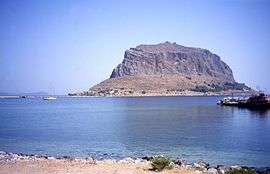Minoa
Minoa is the name of several Bronze-Age cities on the coasts of the Aegean islands and Corfu in Greece, as well as Sicily. The original meaning of the word remains unknown, but it seems that there is a strong connection with the mythic king of Crete, Minos, during the bronze-age Minoan civilization which flourished in Crete and in the Aegean islands in Greece between 2000-1470 BC. The inhabitants of Crete were named Minoans by Arthur Evans, after the legendary king. The root min- corresponds to a group of Aegean languages, and appears also in some toponyms like Minya, Minassos and in the name of the Minyans.[1]

The name was given to some harbours in the north coast of Crete, and it is also an older indication in the islands Paros, Siphnos, Amorgos, Corfu (Korkyra) and Sicily.[2] In Gaza the name was introduced later by the Philistines in 1200 BC.[3] These settlements appear not only in the islands but also in harbours that were specially selected as support-points for thalassocracy. This is evident for an island outside of the Laconic coast with the present name Monemvasia, and for the small island outside of the harbour of Megara in Greece.[2][4]

It seems that the Minoans travelled from Crete down to Egypt, Syria and Mari of Euphrates, to Asia Minor (Anatolia) and Black Sea through the Aegean islands,[5] and to the West up to Lipari (Aeolian islands) to the north of Sicily.[6] Approximately in 1600 BC the routes to Italy and Asia Minor were gained by the rising Myceneans. They followed the same tradition with the establishment or use of commercial and supporting settlements in the Mediterranean coasts.[7]
See also
References
- ↑ F.Schachermeyer (1964).Die Minoische Kultur des alten Kreta.W.Kohlhammer Stuttgart. pp. 301-302
- 1 2 F.Schachermeyer (1964).Die Minoische Kultur des alten Kreta.W.Kohlhammer Stuttgart. p.303
- ↑ Steph. Byzantios: s.v Gaza and Minoa : F.Schachermeyer (1964).Die Minoische Kultur des alten Kreta.W.Kohlhammer Stuttfgart. p.303
- ↑ Pausanias. "The island outside of the harbour Nisaia of Megara was named after the king Minos and was conquered by the Athenians in 427 BC": Fraser, J.G. Commentary, (1913) Pausanias's Description of Greece: Book 1: Attica. Macmillan. pp.549-550
- ↑ F.Schachermeyer.(1964).Die Minoische Kultur des alten Kreta.W.Kohlhammer Stuttgart. pp 79,108
- ↑ F.Schachermeyer.(1964).Die Minoische Kultur des alten Kreta.W.Kohlhammer Stuttgart. p 108
- ↑ F.Schachermeyer.(1964).Die Minoische Kultur des alten Kreta.W.Kohlhammer Stuttgart. pp 98,303-304